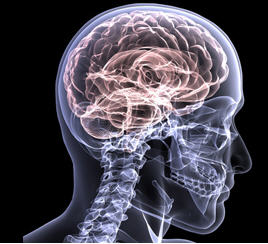Hunting down the trigger for Parkinson’s: failing dopamine pump damages brain cells

It turned out that this pump is less effective at pumping out dopamine and storing it in the brain cells of Parkinson's sufferers. If dopamine is not stored correctly, however, it can cause self-destruction of the affected nerve cells.
In the brain, dopamine mediates the exchange of information between different neurons and, to help it do this, it is continuously reformed at the contact points between the corresponding nerve cells. It is stored in structures known as vesicles (intracellular bubbles) and it is released when required. In people with Parkinson’s disease, the death of these nerve cells causes a lack of dopamine, and this in turn causes the familiar movement problems such as motor retardation, stiffness of the muscles and tremors.
More than 50 years ago, in the Institute of Pharmacology at the University of Vienna (now the MedUni Vienna), Herbert Ehringer and Oleh Hornykiewicz discovered that Parkinson’s disease is caused by a lack of dopamine in certain regions of the brain. This discovery enabled Hornykiewicz to introduce the amino acid L-DOPA into the treatment of Parkinson’s to substitute the dopamine and make the symptoms of the condition manageable for years.
The reasons for the death of nerve cells in Parkinson's disease are not yet fully understood, however, which is why it is still not possible to prevent the disease from developing. Nevertheless, dopamine itself, if it is not stored correctly in vesicles, can cause self-destruction of the affected nerve cells.
Now, a further step forward has been taken in the research into the causes of this disease: a study at the MedUni Vienna’s Centre for Brain Research, led by Christian Pifl and the now 87-year-old Oleh Hornykiewicz, compared the brains of deceased Parkinson's patients with those of a neurologically healthy control group. For the first time, it was possible to prepare the dopamine-storing vesicles from the brains so that their ability to store dopamine by pumping it in could be measured in quantitative terms.
It turned out that the pumps in the vesicles of Parkinson’s sufferers pumped the dopamine out less efficiently. “This pump deficiency and the associated reduction in dopamine storage capacity of the Parkinson’s vesicles could lead to dopamine collecting in the nerve cells, developing its toxic effect and destroying the nerve cells,” explains Christian Pifl.
Journal of Neuroscience
Christian Pifl, Alex Rajput, Harald Reither, Javier Blesa, Carmen Cavada, José A. Obeso, Ali H. Rajput, Oleh Hornykiewicz – Is Parkinson’s disease a vesicular dopamine storage disorder? Evidence from a study in isolated synaptic vesicles of human and non-human primate striatum. Journal of Neuroscience
Media Contact
All latest news from the category: Life Sciences and Chemistry
Articles and reports from the Life Sciences and chemistry area deal with applied and basic research into modern biology, chemistry and human medicine.
Valuable information can be found on a range of life sciences fields including bacteriology, biochemistry, bionics, bioinformatics, biophysics, biotechnology, genetics, geobotany, human biology, marine biology, microbiology, molecular biology, cellular biology, zoology, bioinorganic chemistry, microchemistry and environmental chemistry.
Newest articles

Trotting robots reveal emergence of animal gait transitions
A four-legged robot trained with machine learning by EPFL researchers has learned to avoid falls by spontaneously switching between walking, trotting, and pronking – a milestone for roboticists as well…

Innovation promises to prevent power pole-top fires
Engineers in Australia have found a new way to make power-pole insulators resistant to fire and electrical sparking, promising to prevent dangerous pole-top fires and reduce blackouts. Pole-top fires pose…

Possible alternative to antibiotics produced by bacteria
Antibacterial substance from staphylococci discovered with new mechanism of action against natural competitors. Many bacteria produce substances to gain an advantage over competitors in their highly competitive natural environment. Researchers…





















